Posted on September 3, 2018 | Chukchi Sea polar bears number almost 3000 according to new survey results
The Chukchi Sea finally has a polar bear population estimate! According to survey results from 2016 only recently made public, about 2937 bears (1522-5944) currently inhabit the region, making this the largest subpopulation in the Arctic. This is exciting news — and a huge accomplishment — but the US Fish and Wildlife Service responsible for the work has been oddly mum on the topic.
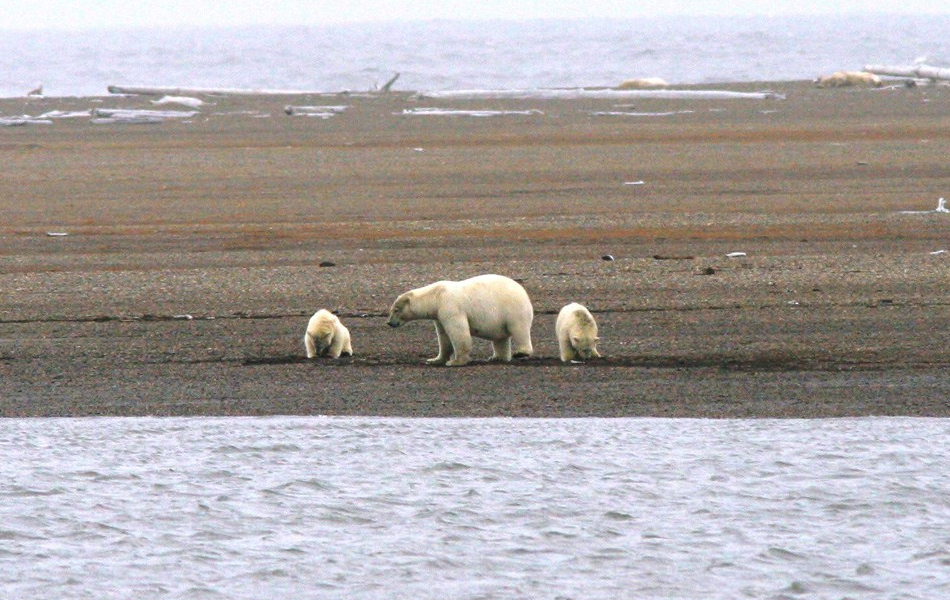
Not only that, but an extrapolation of that estimate calculated by USFWS researchers for Chukchi plus Alaska (the US portion of the Southern Beaufort Sea subpopulation) was estimated at 4437 (2283-9527), although with “significant uncertainty.” Nevertheless, it means the 2016 estimate for Alaska could be roughly three times what it was in 2010: a whopping 1500 or so, up from about 450 (or about 225-650) for the same area estimated during the last survey (Bromaghin et al. 2015: Fig. 5a).
Even if the real number for Alaska is only twice as large (~1000), that’s still a huge improvement. It would eliminate the Southern Beaufort as the only polar bear subpopulation in the Arctic to have shown a significant decline blamed on human-caused global warming (Crockford 2018). If the recovery is real, it means the 2004-2006 decline was a temporary fluctuation after all, just like previous declines in the region. I expect, however, that it will take a dedicated SB population survey for officials to concede that point.
There is not yet now a detailed report to cite (Regehr et al. 2018 in prep, see update below), but the numbers were announced at the 10th meeting of the Russian-American Commission on Polar Bears held at the end of July this year (AC SWG 2018) by Eric Regehr (formerly of the US Fish & Wildlife Service, as of 2017 at the University of Washington). [h/t to G.H.] This was the same report that raised the quota for subsistence hunting in the Chukchi from 58 to 85, based on these new figures, as I discussed last week.
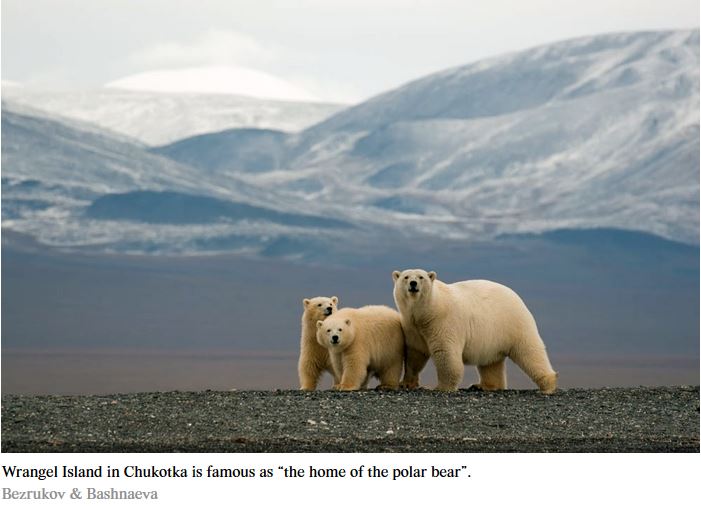
From “Military bases to open on Wrangel Island and Chukotka” 22 October 2015.
Regehr was quoted as saying:
“Chukchi bears remain larger and fatter and have not seen downward trends in cub production and survival, according to new preliminary information on the health and numbers of bears.”
UPDATE 15 November 2018: The scientific paper describing the entirely new method (yes, yet another one: see Bromaghin et al. 2015) used to estimate the size of the Chukchi Sea population is now available (University of Washington press release here), in an open-access paper: Regher et al. 2018. News reports (see one here) spin the postitive outcome as something that researchers expected all along but that’s simply not true. They expected Chukchi Sea bears and Southern Beaufort Sea bears to respond similarly to reduced amounts of summer sea ice, as explained here and in Crockford 2017).
Recent research on polar bears and their prey has been on-going in the Chukchi Sea since 2008 (Crawford et al. 2015; Crawford and Quackenbush 2013; Rode and Regehr 2010; Regehr et al. 2010, Rode et al. 2014, 2015, 2018). Now it’s all coming together to paint a picture of a large population of polar bears in excellent physical condition, with strong reproduction and cub survival (such as triplet litters sighted on numerous occasions), despite a much longer ice-free period in summer than in the 1980s.
Fat bears have been a common summer sight in the Chukchi Sea (see photo below from Sept. 2017 on Wrangel Island) as well as in Alaska. Despite the huge declines in summer sea ice since 2007, Chukchi bears are doing better than OK — they are truly thriving.
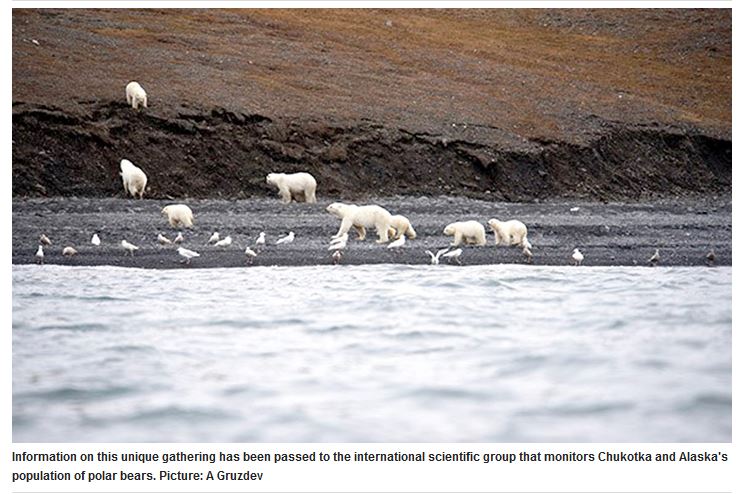
Gone now is the “guesstimate” of about 2000 used by polar bear specialists (but only when they really need one for their models): otherwise, since 2005 the size of the Chukchi was said to be “unknown.”
Given the new estimate, a comparison of the four largest subpopulations (both in area and population size)1 reveals that the 2013 estimate for Kara Sea (3200) is not out of line for its size. However, the population estimate of 1000 for the Laptev Sea is more than two decades out-of-date and very low for a region almost 1,000,000 km2 larger in area than the Chukchi and Kara Seas. See the comparison table of those four subpopulations below, which includes the percentage of each region that lays over the continental shelf (preferred polar bear habitat when it’s ice covered).2 The Laptev Sea population size estimate stands out as an outlier: is almost certainly home to two or three times as many polar bears, especially after decades of zero legal hunting.
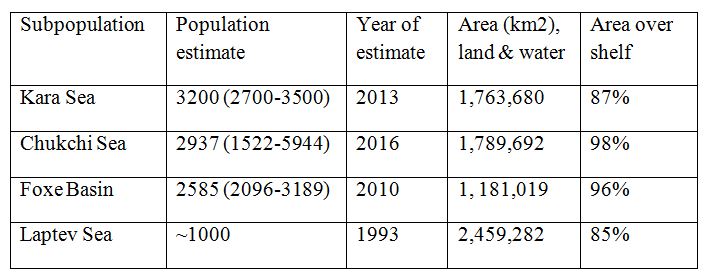
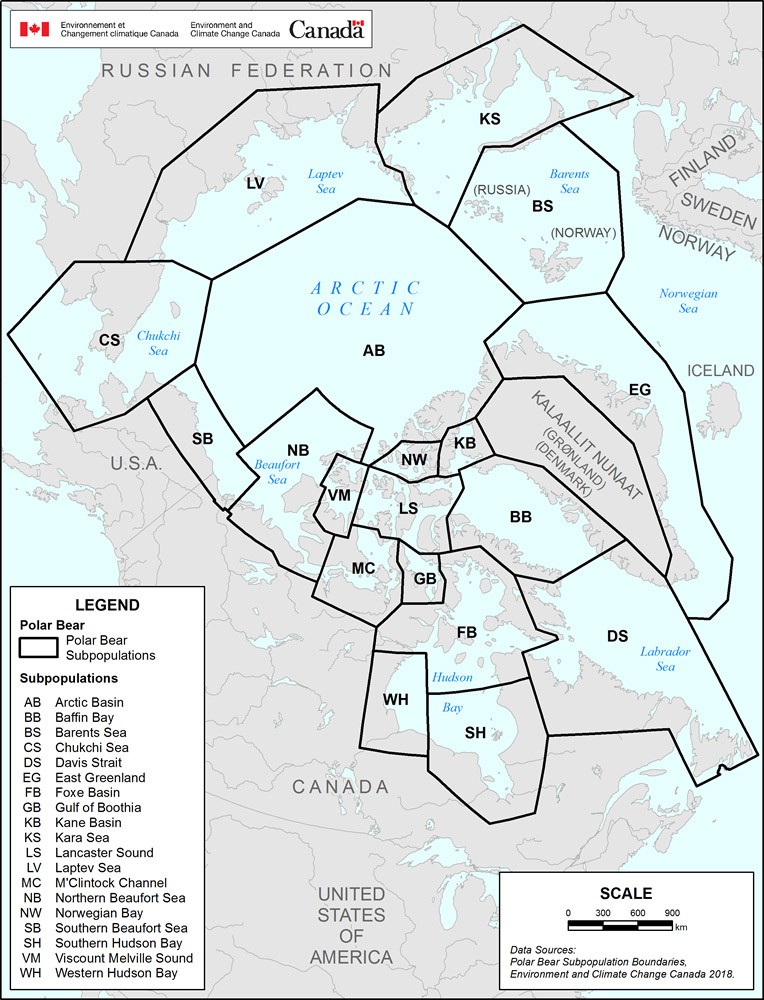
Footnotes.
- These four are the largest only if area and population size are considered together. The Barents Sea is only about 1,158,928 km2 in area, with about 62% over the continental shelf, and an extrapolated population size estimate in 2015 of 3749 (Aars et al. 2017; Crockford 2018). Davis Strait is almost as large in area as the Chukchi Sea (1,703,007 km2), with 42% over continental shelf, but the population size at last count (2007) was 2158 (1833-242) (Peacock et al. 2013).
- Kara Sea population estimate is from Matishove et al. (2014), used by the IUCN in their 2015 Red List assessment (Wiig et al. 2015); Chukchi Sea estimate is from AC SWG (2018); Foxe Basin estimate is from Stapleton et al. (2016); and Laptev Sea estimate is from Aars et al. 2006, used by the IUCN in their 2015 Red List assessment (Wiig et al. 2015). Area size and percentage of area over continental shelf figures are from Hamilton and Derocher (2018).
References
Aars, J., Marques,T.A, Lone, K., Anderson, M., Wiig, Ø., Fløystad, I.M.B., Hagen, S.B. and Buckland, S.T. 2017. The number and distribution of polar bears in the western Barents Sea. Polar Research 36:1. 1374125. doi:10.1080/17518369.2017.1374125
AC SWG 2018. Chukchi-Alaska polar bear population demographic parameter estimation. Eric Regehr, Scientific Working Group (SWG. Report of the Proceedings of the 10th meeting of the Russian-American Commission on Polar Bears, 27-28 July 2018), pg. 5. Published 30 July 2018. US Fish and Wildlife Service. https://www.fws.gov/alaska/fisheries/mmm/polarbear/bilateral.htm pdf here.
Bromaghin, J.F., McDonald, T.L., Stirling, I., Derocher, A.E., Richardson, E.S., Rehehr, E.V., et al. 2015. Polar bear population dynamics in the southern Beaufort Sea during a period of sea ice decline. Ecological Applications 25:634–651.
Crawford, J. & Quakenbush, L. 2013. Ringed seals and climate change: early predictions versus recent observations in Alaska. Presentation by Justin Crawfort, 28th Lowell Wakefield Fisheries Symposium, March 26–29, Anchorage, AK. Available online http://seagrant.uaf.edu/conferences/2013/wakefield-arctic-ecosystems/program.php [accessed June 7, 2013].
Crawford, J.A., Quakenbush, L.T. & Citta, J.J. 2015. A comparison of ringed and bearded seal diet, condition and productivity between historical (1975–1984) and recent (2003–2012) periods in the Alaskan Bering and Chukchi seas. Progress in Oceanography 136:133-150.
Crockford, S.J. 2018. State of the Polar Bear Report 2017. Global Warming Policy Foundation Report #29. London. pdf here.
Peacock, E., Taylor, M.K., Laake, J. & Stirling, I. 2013. Population ecology of polar bears in Davis Strait, Canada and Greenland. Journal of Wildlife Management 77:463–476.
Regehr, E.V., Hostetter, N.J., Wilson, R.R., Rode, K.D., St. Martin, M., Converse, S.J. 2018. Integrated population modeling provides the first empirical estimates of vital rates and abundance for polar bears in the Chukchi Sea. Scientific Reports 8 (1) DOI: 10.1038/s41598-018-34824-7 https://www.nature.com/articles/s41598-018-34824-7
Regehr, E.V., Laidre, K.L, Akçakaya, H.R., Amstrup, S.C., Atwood, T.C., Lunn, N.J., Obbard, M., Stern, H., Thiemann, G.W., & Wiig, Ø. 2016. Conservation status of polar bears (Ursus maritimus) in relation to projected sea-ice declines. Biology Letters 12: 20160556. http://rsbl.royalsocietypublishing.org/content/12/12/20160556
Rode, K. and Regehr, E.V. 2010. Polar bear research in the Chukchi and Bering Seas: A synopsis of 2010 field work. Unpublished report to the US Fish and Wildlife Service, Department of the Interior, Anchorage. pdf here.
Rode, K.D., Douglas, D., Durner, G., Derocher, A.E., Thiemann, G.W., and Budge, S. 2013. Variation in the response of an Arctic top predator experiencing habitat loss: feeding and reproductive ecology of two polar bear populations. Oral presentation by Karyn Rode, 28th Lowell Wakefield Fisheries Symposium, March 26-29. Anchorage, AK.
Rode, K.D., Regehr, E.V., Douglas, D., Durner, G., Derocher, A.E., Thiemann, G.W., and Budge, S. 2014. Variation in the response of an Arctic top predator experiencing habitat loss: feeding and reproductive ecology of two polar bear populations. Global Change Biology 20(1):76-88. http://onlinelibrary.wiley.com/doi/10.1111/gcb.12339/abstract
Rode, K. D., R. R. Wilson, D. C. Douglas, V. Muhlenbruch, T.C. Atwood, E. V. Regehr, E.S. Richardson, N.W. Pilfold, A.E. Derocher, G.M Durner, I. Stirling, S.C. Amstrup, M. S. Martin, A.M. Pagano, and K. Simac. 2018. Spring fasting behavior in a marine apex predator provides an index of ecosystem productivity. Global Change Biology http://onlinelibrary.wiley.com/doi/10.1111/gcb.13933/full
Rode, K.D., Wilson, R.R., Regehr, E.V., St. Martin, M., Douglas, D.C. & Olson, J. 2015. Increased land use by Chukchi Sea polar bears in relation to changing sea ice conditions. PLoS One 10 e0142213.
Stapleton, S., Peacock, E. & Garshelis, D. 2016. Aerial surveys suggest long-term stability in the seasonally ice-free Foxe Basin (Nunavut) polar bear population. Marine Mammal Science 32:181-201.
Wiig, Ø., Amstrup, S., Atwood, T., Laidre, K., Lunn, N., Obbard, M., et al. 2015. Ursus maritimus. The IUCN Red List of Threatened Species 2015: e.T22823A14871490. Available from http://www.iucnredlist.org/details/22823/0 [accessed Nov. 28, 2015]. See the supplement for population figures.
This is good news…the area of the survey only represents around 5% of the entire Arctic Habitat.
3000 bears in 5% of the area could easily equate to more than 30,000 bears over the entire biome.
3000 bears in 5% of the area could easily equate to more than 60,000 bears over the entire biome.
That would be presuming an identical distribution throughout all areas of the Arctic basin which isn’t true
True. It could be much higher in some areas.
“The warming trend in the Arctic is almost twice as large as the global average in recent decades. This is known as Arctic amplification ….”
Arctic amplification makes polar bears trive, one more proof that global warming is good.
Guess those guys didn’t get the imminent extinction memo.
Apparently yet another failed prediction .
If you’re going to make a prediction, you should have a clue about what happened before. Polar bears survived the Holocene climate optimum when there was less sea ice than there is now. Predicting that a decrease in sea ice will be a problem for polar bears … maybe that itself is a problem.
CommieBob November 20, 2018 at 11:22 am
If you’re going to make a prediction …
The most important lesson in Climate Science:
Never make a prediction on a timeline that expires before you do.
commieBob – November 20, 2018 at 11:22 am
T’wasn’t a prediction, it was a “scare tactic” disguised as being a prediction.
Anyway, to wit:
Excerpted from published commentary:
For the past 10+ years I have been telling everyone that the loss of sea ice in the Arctic is the best thing that could happen for the Polar Bears.
Melting sea ice simply moves/concentrates the Polar Bear’s “lunch counters” closer to shore.
Another…. and, another, and, another….. ad nauseum.
Yet we’ll still have activists dressing up in Polar bear costumes to advertise their impending extinction caused by global warming.
I might welcome the extinction of environmental activists regardless of what costumes they care to wear.
And they all look fat and healthy. It’s almost like they don’t need sea ice to survive or something.
You fattist…
Good! Does this mean they will increase the number of permits issued for hunting Polar Bears now?
Thriving apex predator population reflects a robust state of the food chain.
Increasing the base of the food chain leads to more life.
CO2 is the base of the food chain for Carbon Based Life Forms.
I guess sending all that coca-cola up there really worked… :-\
https://www.worldofcoca-cola.com/explore/explore-inside/explore-coca-cola-polar-bear/
Who’d a thunk it?
And the penguins?
Well I say! This is rather awkward.
Umm……
Umm…..
I know! The population would be 10 times greater but for Global Man Made Catastrophic Anthropogenic Climate Change Disaster Catastrophe. I’ll need a generous grant to be able to research that mind you.
Or the entire global population of polar bears has moved to this particular region. For some climate related reason. Can I have another grant?
Or something.
I hate F&W….the grow a population…and then claim we are in their territory
Paging Al Gore… you have an inconvenient truth waiting for you.
Has anyone plotted population against rise of the life molecule in the atmosphere? It has to be 9n someones to do list.
The government of Nunavut, a huge territory in Northern Canada, says there are too many polar bears and climate change isn’t affecting them. link Naturally, federal government and university scientists disagree.
I heard the premier of Nunavut talking on the radio about the subject. He was a lot more convincing than the government scientists. The fact that I found most compelling is that female bears are having two cubs and those cubs look fat and healthy.
On Nov. 14, CBC Network broadcast a 1:26 video clip of a Nunavut Inuit saying that there were too many polar bears. So I eagerly awaited a rebroadcast on CBC’s “The National”, the flagship daily news show of the Canadian Broadcasting Corporation. It wasn’t shown!!! Perhaps our betters, the smarter elite journalists and editors decided that this would raise doubts about the seriousness of climate change, and adversely affect our judgment of Liberal Prime Minister Justin Trudeau and his brain, Gerald Butts, and the Carbon Tax they are determined to force on all Canadians (with punitive action against provinces that won’t go along, now including Ontario, Manitoba and Saskatchewan, with Jason Kenney’s Alberta to come).
Next we’ll be told that obese polar bears are dying because of heart disease and diabetes, a result of too much food caused by ‘Climate Change’. /s
Seriously, this is excellent news on the thriving polar bears. It indicates a healthy ecology necessary to support these apex predators.
Mods: Typo – “UPDATE 15 November 2018: The scientific paper describing the entirely new method (yes, yet another one: see Bromaghin et al. 2015) used to estimate the size of the Chukchi Sea population is now svailable…..
(Got it, thank you) MOD
Well, you know those polar bears – they are such extinction deniers.
Yeah … or what if Big Oil is actually surreptitiously feeding all those poor little polar bears dog food or something, at night, just to make the climate “scientists” look bad … and then when we all decide to kill off the Campaign to Save the Planet, those mean old oil tyrants will jerk the rug out from under all the polar bears, stop feeding them, as they gleefully chortle over their poor dying carcasses when the ice goes away forever.
Mockery is such fun.
“It would eliminate the Southern Beaufort as the only polar bear subpopulation in the Arctic to have shown a significant decline blamed on human-caused global warming (Crockford 2018).” But Crockford says, “A decline in numbers occurred during a period when summer sea ice had declined markedly (2001–2010) but the proximate cause of the population decline was a series of thick spring ice events in 2004–2006 that drove seals out of the region.” In other words, not global warming, but a cyclic cold pattern.
Thanks for reminding us of this. It is not summer sea ice that affects seals and polar bears. It is spring ice. And guess what? There is always going to be spring ice. Occasionally there is too much spring ice, causing a disruption in the polar bear’s food chain.
Maybe there was never a problem in the first place!
buh buh buh … but we thought the “science was settled”?
How can this be that we didn’t know everything we ever needed to know when the IPCC report was first published?
So does this mean we DON”T know everything there is to know about global warming, and what is causing it, and what its effects will be on all the little critters and us poor dumb polluting humans?
The only large mammalian species-subspecies that appear incapable of adaptation in the face of change is Homo sapiens sub. Climacultia and their closely related cousins H. sapiens sub. Rentseekia.
+42 Nonillion
Or if you would prefer
+42 Tredecillion
Extinction of these subspecies can only be welcomed.
UN environment chief resigns
Erik Solheim has resigned following criticism of his frequent global travels.
Yup, according to THE GUARDIAN (linked below):
“A draft internal UN audit leaked to the Guardian in September found Solheim had spent almost $500,000 (£390,000) on air travel and hotels in just 22 months, and was away 80% of the time. The audit said this was a “reputation risk” for an organisation dedicated to fighting climate change.”
Link:
https://www.theguardian.com/environment/2018/nov/20/un-environment-chief-erik-solheim-resigns-flying-revelations
Not even powerful CO2 can keep a good Polar Bear down! This is yet more bad news for Al Gore.
What polar bears thriving how dare they didn’t they get the memo?
James Bull
Whilst a different location, how is the brown bear doing. As its almost identical to the white bear, they can interbreed, how are they faring, or does the Greens climate change only apply to the Polar bear ?
MJE
Good point! Brown bears, especially the Kodiak Brown Bear are as healthy as ever. But as this study points out, as well as the Nunavut study on an actual over population of Polar Bears, populations are healthy. There seems to be nothing wrong environmentally or with the climate from allowing these bears to thrive. Hopefully the propaganda due to climate change issues on the Polar Bear is over. They too are probably benefiting greatly from the Arctic warming, for how ever long this cycle lasts.
Polar bears would definitely snack on Gore meat. They actually will hunt humans.
“During a 20-year period in Canada, six deaths and 14 injuries were reported. 15 of these incidents were “considered to be acts of predation by the bear.”
no, no- everyone knows that polar bear numbers are falling- follow the Gourd! not the sandal!
No bears were counted it’s another darned model used to estimate population size. Every word about numbers of animals and risks and etc. is driven by their estimates based on modeling.
‘Something has changed:’ Three bear species found in same northern Manitoba spot
https://www.carlyleobserver.com/something-has-changed-three-bear-species-found-in-same-northern-manitoba-spot-1.23505369
Hey, Al Gore, what say you?
This really pisses me off:
https://www.cnet.com/news/polar-bears-threatened-by-climate-change-have-one-safe-haven/
How does cnet “report” this good news? By rehashing all the discredited studies.
> Grim news about polar bears struggling to survive in a changing world isn’t new, but one small light flickers against the dark.